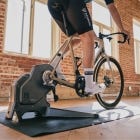Choosing new wheels for your road bike may seem like a daunting endeavour, especially considering the seemingly infinite options on the market today. By establishing what your typical rides and covered terrain ressemble, you will be on your way to figuring out what best suits your needs.
Obviously, one must also determine their braking interface, whether it be disc or rim brake. There are multiple pros and cons to both and a lot of choice for either system.
Disc Brakes
The newest innovation for road bikes, disc brakes offer the best braking performance thanks to greater heat management, all-weather braking performance and excellent modulation/control. In addition, disc-brake specific wheels sustain less damage and remain in better condition in the long term as there is no direct contact to the rim during braking.
That being said, they do have some disadvantages – most notably, they are usually more expensive, require more skill and regular maintenance, are on average 600-800g heavier and also less aerodynamic.
Rim Brakes
The tried and true braking system, rim brakes are slowly being phased out from the market. While disc brakes are probably the best option for most cyclists, high performance riders and racers who value weight savings and aerodynamic properties over braking performance will choose rim brakes – hence, they should still remain an option for years to come.
Most wheels on the market today are available in both rim or disc brake options.
Materials
Aluminium
Price : 2000$ and under
Aluminium is the most common material used in building road wheels. Chosen for its robustness, durability, lightweight, aluminium allows for a quality product at an affordable price point. Although carbon is the most coveted material nowadays, alloy remains the best choice for a good number of cyclists, mainly because of the value it offers.
In some cases, aluminium wheels can be as light if not lighter than some carbon wheels and offer stiffness and durability at a price that would triple if they were made from carbon.
Also, aluminium braking tracks can offer better braking performance than carbon, especially in wet conditions, a point to consider if you ride a rim brake bike.
Aluminium/Carbon
Price : 1000 – 2500$
Because of the gradual lowering of prices for full carbon wheels, this category is slowly disappearing. Carbon enhanced alloy rims are the logical intermediary between alloy and carbon wheels – pricewise and performance wise. Their goal is to offer greater aerodynamic properties at a more affordable price point. The alloy rim keeps its great braking performance and stiffness, while the carbon fairing has a deep section, aerodynamic profile. The only downside to this system is the higher weight generated by the pairing of two materials.
Carbon
Price : 1600 – 5000$
The most advanced wheels on the market, carbon rims are also the stiffest, lightest and most aerodynamic option. Carbon as a material is the only option that allows for the combination these three properties.
In the past, fragility was often associated with carbon rims, and with reason – carbon as a whole has only been widespread in the cycling industry for 15 years. While true in their beginning, recent technological advancements have brought carbon innovation to the next level, to the point that durability or integrity are no longer a worry.
Profile
This is where finding out your preferred terrain comes into play. Companies approach this in a number of different ways, but the principle remains the same.
40mm and under:
These are the wheels of mountain goats. You spend most of your time in the hills and the only gains that are important to you are ones in elevation. Combined with a stiff and lightweight rim brake equipped bike, your dream build is topped with extremely light and shallow carbon wheels, for maximal weight savings.
40-60mm
If versatility and performance are what you seek, look no further than the 40-55mm profile. It is proven that aerodynamic properties are still in effect in climbs up to 6% in gradient, so why not take advantage of nature’s design? These are the wheels for varied terrain – from flat, high speed chases to punchy, short climbs.
65mm and more
For maximum speed and aerodynamics, 65mm and over is the way to go. If you tend to stay on flat roads and are excited by high speed pacing, the deeper the profile the better. As we get into this range, time-trialing, triathlon and criterium racing are their best applications.
Tire Systems
Clincher Tires
The most common tire interface, clinchers use an open bottom tire, housing a rubber inner tube. While they may not offer the least rolling resistance and lightest weight, they are very simple in use and are quite inexpensive. There are many different clincher tire options on the market for different applications, and are the easiest to deal with in the case of a roadside puncture.
Tubeless Tires
Predominantly used in off-road discipline, tubeless tires are similar to clincher tires in that they are opened bottomed, but they do not house an inner tube. Rather, the tire-rim interface is sealed by a latex sealant which offers great puncture protection by instantly sealing up new holes. Another strong point for tubeless tires is the possibility of running much lower pressures as the risk of pinching the inner tube is non-existent. Lower pressures mean better traction, power transfer and a more comfortable ride.
In order to use tubeless tires, one must have a tubeless ready rim, sealed rim bed and a tubeless ready tire. Despite all of their advantages, they are quite more expensive and require a compressor for proper installation. Once installed, they are quite reliable and roadside puncture kits specific to tubeless tires do exist, such as Lezyne Tubeless CO2 Blaster 2-in-1.
Tubular Tires
The original tire system, tubular tires have a closed bottom interface, housing a latex inner tube. The tire is then glued to the rim with carbon cement. Their advantages are plenty – tubular tires are the lightest option, offer the least rolling resistance, respectable puncture protection and exceptional road feel/traction.
The most expensive system to use, tubular tires are quite unpractical. Roadside punctures are impossible to fix and the glueing process is extensive. Normally reserved for high-level athletes, tubulars are slowly being phased out.
For more information on our road wheels, don’t hesitate to ask our in-store and online experts.










